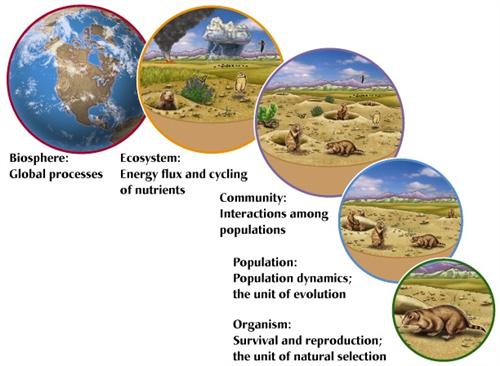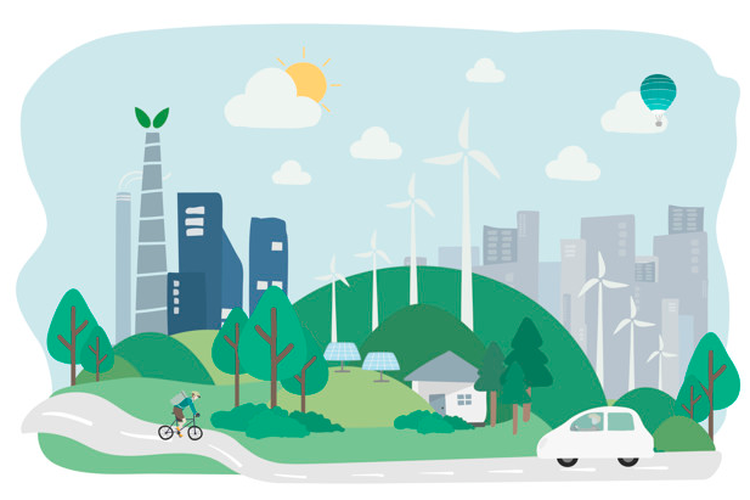Ecology Introduction
What is ecology?
Ecology is a science that studies and learn the relationship between animals and their environment, both organic and non-organic, and their reciprocal relationship with plants competing with each other for survival.
The phrase was popularized by a biologist from Germany named Ernst Haeckel in 1866 where Haeckel popularized the phrase "Ecology" which comes from Oikos, the Greek word for home, to categorize the branch of biology that studies phenomena that occur around us. This phenomenon occurs naturally in our environment and has been going on for a long time. People who study this science are called ecologists. Explanations about ecology are not limited to researchers only, someone who is curious and finds out about the natural processes that occur around him such as observing the types of fish caught every month and changes that occur from time to time can also be categorized as an ecologist. The natural processes observed by ecologists include two distinct but related to each other, namely, the interaction of living organisms with the Physico-chemical components of their environment (biotic-abiotic interactions). Ecologists will generally attempt to identify an observable pattern, a recurring variable that occurs over time that affects an organism in both its abundance and geographical distribution, and the movement of energy that occurs naturally within an environmental system.
How do we learn about ecology?
Ecologists study the processes that occur and the patterns that appear in an ecosystem-based on time, location, size complexity that can affect an ecosystem globally.
The approach used to study ecology is divided into several concepts and principles that overlap (relate) to each other. Some of the approaches, concepts, and principles referred to include organism ecology, population ecology, community ecology, ecosystems, and global ecology. Each of the concepts mentioned is arranged based on hierarchy or levels starting from the smallest scope, namely ecology at the organism or individual level to the most extensive on a global or global scale.
 This level of ecological hierarchy was popularized by Eugene Odum in 1953. However, today's ecologists tend to describe ecology not as rigidly as ecologists in the 1950s such as Odum with hierarchy or ecological levels where ecologists today (2020s) tend to explain ecology flexibly and sweetly based on certain points of view. Odum's explanation of the hierarchy of ecological levels can help understand what ecology is wherein the hierarchy, ecology is interconnected with each other with complex relationships where at each level it will be easy to understand if you understand the previous smaller level and can easily see or know the pattern. that occur at every level of the ecology that over time continues to change.
This level of ecological hierarchy was popularized by Eugene Odum in 1953. However, today's ecologists tend to describe ecology not as rigidly as ecologists in the 1950s such as Odum with hierarchy or ecological levels where ecologists today (2020s) tend to explain ecology flexibly and sweetly based on certain points of view. Odum's explanation of the hierarchy of ecological levels can help understand what ecology is wherein the hierarchy, ecology is interconnected with each other with complex relationships where at each level it will be easy to understand if you understand the previous smaller level and can easily see or know the pattern. that occur at every level of the ecology that over time continues to change.
Ecology at the organismal level
We as humans tend to imitate and learn what we see especially from nature
Like submarines made by humans, humans learn this from nature, especially in certain organisms. Man-made submarines use echolocation technology similar to dolphins in deep-sea maneuvers. Ecologists study certain organisms and their adaptation to certain environments or conditions such as dolphins adapting with the help of echolocation. Other ecologists with a similar object, namely dolphins, can ask various questions such as: does each group of dolphins have different echolocation signals? is echolocation their form of communication? Ecological questions like this can provide clues in understanding the evolutionary process that occurs, by answering these questions, the pattern of adaptation in an organism that can encourage the level of survival and reproduction can be known and studied and even imitated by humans.
Ecology at the population level
How large a coral ecosystem must be maintained in order to maintain food for the dolphins? Should predators such as sharks or humans intervene directly to maintain the dolphin population? How many of a type of dolphin can live in an area (maximum capacity of an area). Population ecologists study how and what causes the number of a given organism to change over time. Population sentences describe a group of organisms of the same type living in an area that lives at the same time. Ecologists usually use several methods of studying ecology at the population level such as genetic analysis and demographic models or mathematical models (e.g. determining birth rates and death rates) to find out changes in a population and what factors affect its increase, decrease regulation, and dynamics of a population. With the help of this method, ecologists can predict the changes that occur and how to manage a population of species, especially those closely related to humans (agriculture and animal husbandry), populations that must be protected (endangered species), or populations that want to be eliminated (pests). , disease, invasive species). How a population is studied by ecologists depends on how ecologists are asked or the approach they use to study a population. Ecologists can use genetic criteria, or geographic boundaries, to study a population.
Ecology at the community level
Community is a combination of populations of different species living in one place at the same time
Understanding community in ecology can help us find answers to questions such as: How many species of mangroves can live in a coastal area? How does a coral reef respond to the loss of species that clean coral reefs? How can microscopic diseases on coral reefs change the entire coral reef ecosystem to become unhealthy and even severely damaged? There are many definitions related to the ecological community however, the community is not bound by physical boundaries where a population of a species can move in and out of an area. Researchers generally focus on a few dominant species or species that interact with the species being studied. At the community level, ecologists can study the relationships between groups of species (predation, primary producers, competence, mutualism, or even parasitism) and how these interactions affect community structures related to the diversity and number of species present in the area.
Ecology at the ecosystem level
An expert in his field, the British botanist Arthur Tansley observed that biologists focused only on an organism rather than the movement and exchange of material and energy between organisms and the environment in which they lived. In 1935, Tansley coined the phrase "ecosystem", meaning ecological system, to assess the importance of studying the exchange of materials and energy that occurs in the study of ecology. Ecologists who study ecology at the community level interact with their environment in a unified system - an ecosystem. Ecologists can define ecosystems based on the dominant environment, dominant species (mangrove forests, seagrass beds, coral reefs), natural boundaries (cliffs, mountains, rivers), artificial boundaries (national parks). As before, ecosystems can be understood depending on the questions ecologists ask.
Ecology on a global level
At the global level, ecologists study the patterns that occur globally and the dynamics (ocean currents, wind speed and distribution, continental plate tectonics, and climate change) that affect geographic changes in the distribution and abundance of a population and the function and productivity of an ecosystem. Ecological studies at the global level focus on how humans play an effective role in the functioning of the biosphere where humans live.
Referencesce
Campbell, N. A., Reece, J. B., Urry, L. A., Cain, M. L., Wasserman, S. A., Minorsky, P. V., & Jackson, R. B. (2008). Biology (8th ed.) San Francisco: Pearson Benjamin Cumming.
Chapin III, F. S., Matson, P. A., & Mooney, H. A. (2002). Principles of Terrestrial Ecosystem Ecology. New York: Springer.
Currie, W. S. (2011). Units of nature or processes across scales? The ecosystem concept at age 75. New Phytologist, 190(1), 21-34.
Ricklefs, R. E., & Relyea, R. (2014). Ecology the Economy of Nature. New York: W. H. Freeman and Company.
Rockström, J., et al. (2009). A safe operating space for humanity. Nature, 461(7263), 472-475.
Venter, O., et al. (2016). Sixteen years of change in the global terrestrial human footprint and implications for biodiversity conservation. Nature Communications, 7(12558). doi:10.1038/ncomms12558
Whittaker, R. H. (1975). Communities and Ecosystems (2nd ed). New York: Macmillan.

Comments
Post a Comment